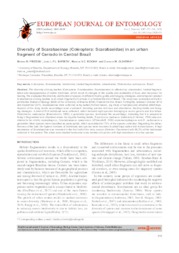Diversity of Scarabaeinae (Coleoptera: Scarabaeidae) in an urban fragment of Cerrado in Central Brazil.
Diversity of Scarabaeinae (Coleoptera: Scarabaeidae) in an urban fragment of Cerrado in Central Brazil.
Author(s): FRIZZAS, M. R.; BATISTA, J. L. F. L.; ROCHA, M. V. C.; OLIVEIRA, C. M. de
Summary: Abstract. The diversity of dung beetles (Coleoptera: Scarabaeidae: Scarabaeinae) is affected by urbanization, habitat fragmentation and disappearance of native mammals, which result in changes in the quality and availability of food, and resources for nesting. We evaluated the diversity, distribution of species in different trophic guilds and foraging strategies, and temporal variation in abundance of dung beetles in an urban fragment of Cerrado in a Federal District of Brazil. This study was conducted at the Experimental Station of Biology (EEB) of the University of Brasília (UnB), Federal District, Brazil. Fortnightly, between October 2012 and September 2013, Scarabaeinae were collected using baited (human faeces, pig meat, or banana) and unbaited pitfall traps. Aspects of the dung beetle assemblage were evaluated, including species richness and abundance, feeding habits and foraging strategies. A total of 614 individuals were collected, which included eight species belonging to seven genera and four tribes. Dichotomius carbonarius (Mannerheim, 1829), a generalist species, dominated the assemblage, indicating that it is adapted to living in fragmented and urbanized areas. As regards feeding habits, Eurysternus caribaeus (Jablonsky & Herbst, 1789) was considered to be strictly coprophagous, Coprophanaeus cyanescens (d?Olsoufi eff, 1924) copronecrophagous and D. carbonarius a generalist. Most species were classifi ed as paracoprids, which accounted for 75% of the species collected. Regarding the attractiveness of the bait, the highest numbers of individuals and species were recorded in pitfall traps baited with human faeces. A high abundance of Scarabaeinae was recorded in the fi rst half of the rainy season (October?December) with 98.2% of the individuals collected in this period. The urban area studied harboured a low number of species with high abundance of a few species.
Publication year: 2020
Types of publication: Journal article
Unit: Embrapa Cerrados
Keywords: Besouro, Biodiversidade, Coleoptera, Scarabaeidae, Urbanização
Observation
Some of Embrapa's publications are published as ePub files. To read them, use or download one of the following free software options to your computer or mobile device. Android: Google Play Books; IOS: iBooks; Windows and Linux: Calibre.
Access other publications
Access the Agricultural Research Database (BDPA) to consult Embrapa's full library collection and records.
Visit Embrapa Bookstore to purchase books and other publications sold by Embrapa.

